The term homeostasis is used by physiologists to mean maintenance of nearly constant conditions in the internal environment. Essentially all organs and tissues of the body perform functions that help maintain these relatively constant conditions. For instance, the lungs provide oxygen to the extracellular fluid to replenish the oxygen used by the cells, the kidneys maintain constant ion concentrations, and the gastrointestinal system provides nutrients.
The term homeostasis comes from the Ancient Greek ὅμοιος (hómoios (homeo), meaning “similar”), from στημι (hístēmi (stasis), “standing still”) and stasis, from στάσις (stásis, meaning “standing”). The concept of homeostasis was first described in 1865 by Claude Bernard, a French physiologist. However, the term was coined later in 1962 by the American physiologist Walter Bradford Cannon.
Concept of Extracellular and Intracellular fluid
- Intracellular fluid—fluid contained within all of the cells of the body
- Extracellular fluid—fluid outside the cells of the body and is the intern
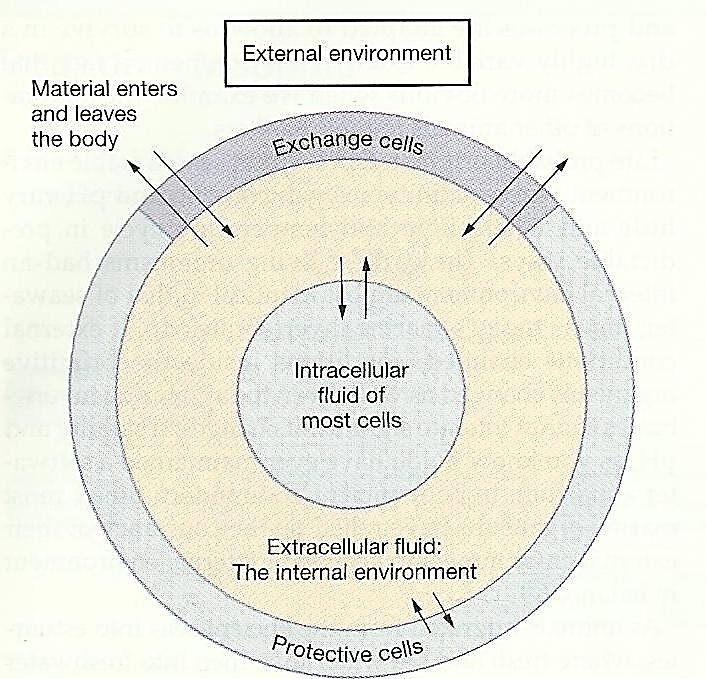 al environment in which the cells live. It is composed of plasma and interstitial fluid.
al environment in which the cells live. It is composed of plasma and interstitial fluid.
Interdependent relationship of cells, systems and homeostasis
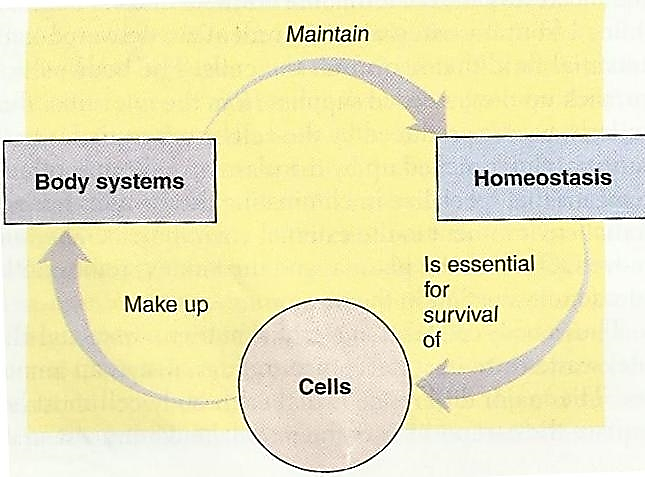
Factors homeostatically regulated
- Concentration of nutrient molecules
- Concentration of CO2 andO2
- Concentration of waste products
- pH
- Concentration of water, salt and other electrolytes
- Temperature
- Volume and pressure
Contribution of body systems to Homeostasis
- The Circulatory System
- Extracellular fluid is transported through all parts of the body in two stages. The first stage is movement of blood through the body in the blood vessels, and the second is movement of fluid between the blood capillaries and the intercellular spaces between the tissue cells.
- All the blood in the circulation traverses the entire circulatory circuit an average of once each minute when the body is at rest and as many as six times each minute when a person is extremely active.
- As blood passes through the blood capillaries, continual exchange of extracellular fluid also occurs between the plasma portion of the blood and the interstitial fluid that fills the intercellular spaces.
- The Digestive System
- A large portion of the blood pumped by the heart also passes through the walls of the gastrointestinal tract. Here different dissolved nutrients, including carbohydrates, fatty acids, and amino acids, are absorbed from the ingested food into the extracellular fluid of the blood.
- Undigested material that enters the gastrointestinal tract and some waste products of metabolism are eliminated in the feces.
- The Respiratory System
- The blood picks up oxygen in the alveoli, thus acquiring the oxygen needed by the cells. The membrane between the alveoli and the lumen of the pulmonary capillaries, the alveolar membrane, is only 0.4 to 2.0 micrometers thick, and oxygen rapidly diffuses by molecular motion through this membrane into the blood.
- Removal of Carbon Dioxide by the Lungs. At the same time that blood picks up oxygen in the lungs, carbon dioxide is released from the blood into the lung alveoli; the respiratory movement of air into and out of the lungs carries the carbon dioxide to the atmosphere. Carbon dioxide is the most abundant of all the end products of metabolism.
- The Urinary System
- Passage of the blood through the kidneys removes from the plasma most of the other substances besides carbon dioxide that are not needed by the cells.
- These substances include different end products of cellular metabolism, such as urea and uric acid; they also include excesses of ions and water from the food that might have accumulated in the extracellular fluid.
- The kidneys perform their function by first filtering large quantities of plasma through the glomeruli into the tubules and then reabsorbing into the blood those substances needed by the body, such as glucose, amino acids, appropriate amounts of water, and many of the ions. Most of the other substances that are not needed by the body, especially the metabolic end products such as urea, are reabsorbed poorly and pass through the renal tubules into the urine.
- The Musculoskeletal system
- How does the musculoskeletal system contribute to homeostasis? The answer is obvious and simple: Were it not for the muscles, the body could not move to the appropriate place at the appropriate time to obtain the foods required for nutrition. The musculoskeletal system also provides motility for protection against adverse surroundings, without which the entire body, along with its homeostatic mechanisms, could be destroyed instantaneously.
- The Integumentary System
- The skin and its various appendages, including the hair, nails, glands, and other structures, cover, cushion, and protect the deeper tissues and organs of the body and generally provide a boundary between the body’s internal environment and the outside world. The integumentary system is also important for temperature regulation and excretion of wastes and it provides a sensory interface between the body and the external environment. The skin generally comprises about 12 to 15 percent of body weight.
- The Immune System
- The immune system consists of the white blood cells, tissue cells derived from white blood cells, the thymus, lymph nodes, and lymph vessels that protect the body from pathogens such as bacteria, viruses, parasites, and fungi. The immune system provides a mechanism for the body to (1) distinguish its own cells from foreign cells and substances and (2) destroy the invader by phagocytosis or by producing sensitized lymphocytes or specialized proteins (e.g., antibodies) that either destroy or neutralize the invader.
- The Nervous System
- The nervous system is composed of three major parts: the sensory input portion, the central nervous system (or integrative portion), and the motor output portion. Sensory receptors detect the state of the body or the state of the surroundings. For instance, receptors in the skin apprise one whenever an object touches the skin at any point. The eyes are sensory organs that give one a visual image of the surrounding area. The ears are also sensory organs. The central nervous system is composed of the brain and spinal cord. The brain can store information, generate thoughts, create ambition, and determine reactions that the body performs in response to the sensations. Appropriate signals are then transmitted through the motor output portion of the nervous system to carry out one’s desires.
- The Endocrine System
- Located in the body are eight major endocrine glands that secrete chemical substances called hormones. Hormones are transported in the extracellular fluid to all parts of the body to help regulate cellular function. For instance, thyroid hormone increases the rates of most chemical reactions in all cells, thus helping to set the tempo of bodily activity. Insulin controls glucose metabolism; adrenocortical hormones control sodium ion, potassium ion, and protein metabolism; and parathyroid hormone controls bone calcium and phosphate. Thus, the hormones provide a system for regulation that complements the nervous system.
- Reproductive system
- Sometimes reproduction is not considered a homeostatic function. It does, however, help maintain homeostasis by generating new beings to take the place of those that are dying. This may sound like a permissive usage of the term homeostasis, but it illustrates that, in the final analysis, essentially all body structures are organized such that they help maintain the automaticity and continuity of life.
Homeostatic Control System
It is a functionally interconnected network of body components that operate to maintain a given physical or chemical factor in the internal environment relatively constant around an optimal level.
The human body has thousands of control systems. The most intricate of these are the genetic control systems that operate in all cells to help control intracellular function and extracellular functions.
Many other control systems operate within the organs to control functions of the individual parts of the organs; others operate throughout the entire body to control the interrelations between the organs. For instance, the respiratory system, operating in association with the nervous system, regulates the concentration of carbon dioxide in the extracellular fluid. The liver and pancreas regulate the concentration of glucose in the extracellular fluid, and the kidneys regulate concentrations of hydrogen, sodium, potassium, phosphate, and other ions in the extracellular fluid. Can be classified as:
- Intrinsic (local controls) are inherent compensatory responses of an organ to a change
- Extrinsic controls are responses of an organ that are triggered by factors external to the organ, namely, by the nervous and endocrine systems
Both intrinsic and extrinsic control systems generally operate on the principle of
- Negative feedback mechanism
In addition
- Positive feedback mechanism
- Feedforward mechanism
Negative feedback is a mechanism that reverses a deviation from the set point. Therefore, negative feedback maintains body parameters within their normal range. The maintenance of homeostasis by negative feedback goes on throughout the body at all times, and an understanding of negative feedback is thus fundamental to an understanding of human physiology.
Change in a homeostatically control factor triggers a response that seeks to restore the factor to normal by moving the factor in the opposite direction of its initial change or it is a pathway where the response opposes or removes the signal.
If the results suppress or stops the original signal, then it is said to be negative feedback mechanism.
Most of the mechanisms of the body belongs to this category
Feedback loop steps:
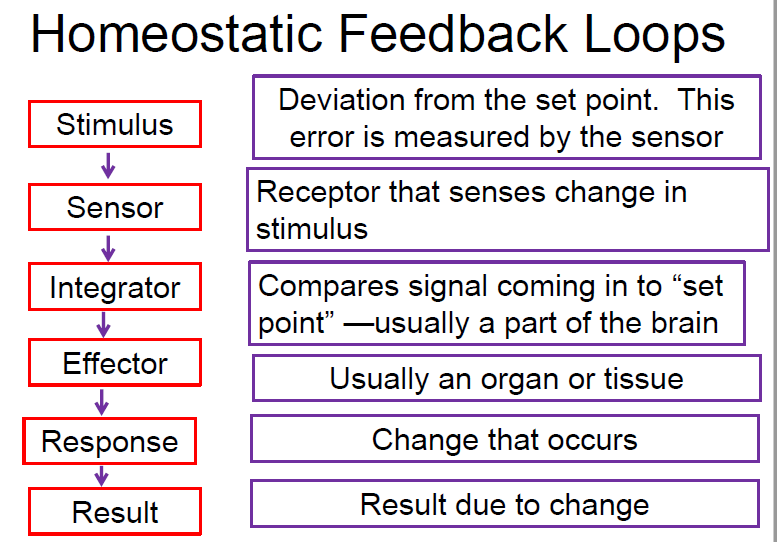
- Stimulus
- Sensor
- Integrator
- Effector
- Response
- Result
Examples of Negative feedback:
Blood Pressure:
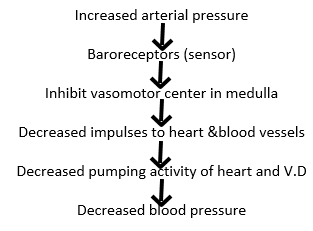
CO2
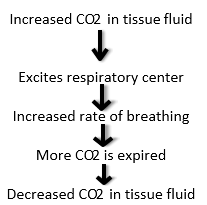
Thermoregulation:
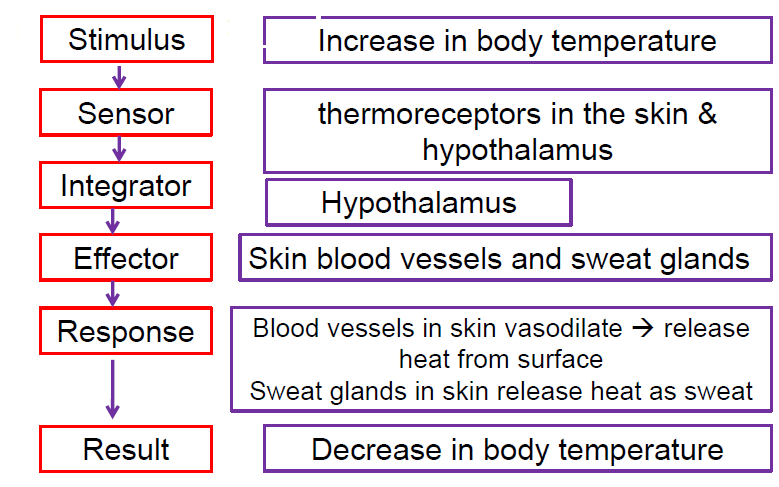
Positive feedback
Positive feedback intensifies a change in the body’s physiological condition rather than reversing it. A deviation from the normal range results in more change, and the system moves farther away from the normal range. Positive feedback in the body is normal only when there is a definite end point. Childbirth and the body’s response to blood loss are two examples of positive feedback loops that are normal but are activated only when needed.
Childbirth at full term is an example of a situation in which the maintenance of the existing body state is not desired. Enormous changes in the mother’s body are required to expel the baby at the end of pregnancy. And the events of childbirth, once begun, must progress rapidly to a conclusion or the life of the mother and the baby are at risk. The extreme muscular work of labor and delivery are the result of a positive feedback system.
- The output is continually enhanced or amplified so that the controlled variable continues to be moved in the direction of the initial change or a pathway in which the response reinforces the stimulus.
- It is also precisely defined as “if the response enhances the original stimulus it is called positive feedback mechanism.
- It is also called vicious cycle in some cases.
Examples:
Childbirth:
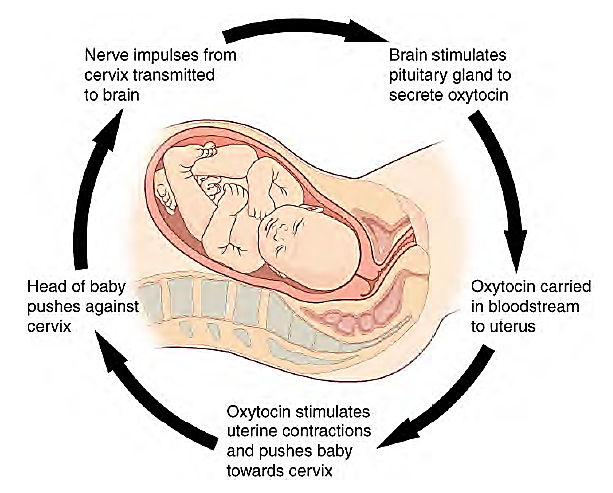
Blood clotting:
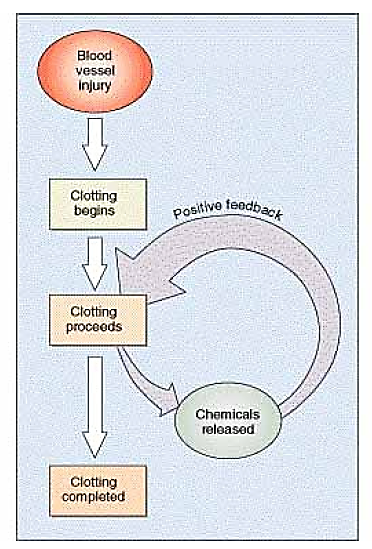
Breastfeeding:
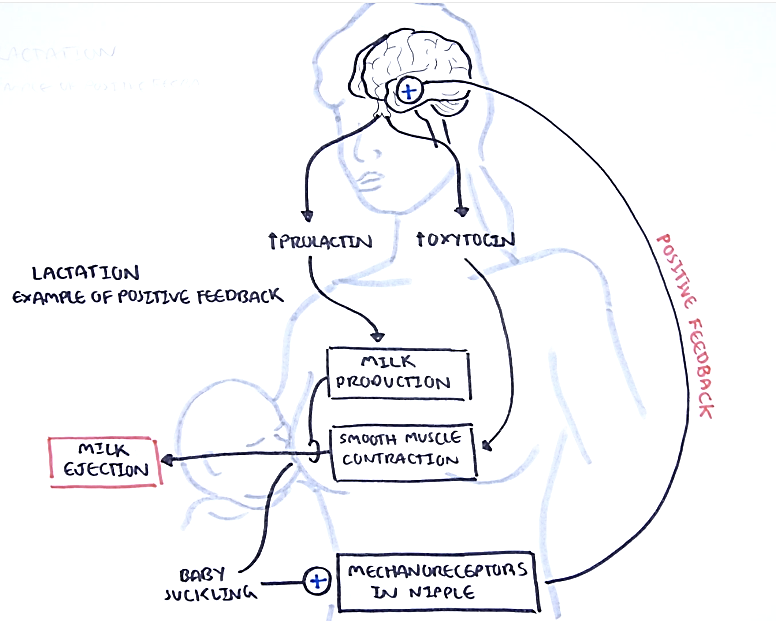
Feedforward Mechanism
It brings about a compensatory response in anticipation of a change in a regulated variable.
In this mechanism our body gives response prior to signals sent by brain.
Examples
- Production of saliva in the mouth when we see the food.
- Secretion of HCL in stomach when we engulf the food.
- Drawback of our hand instantly when we touch a hot pot.
Key Points
- Homeostatic control mechanisms have at least three interdependent components: a receptor, integrating center, and effector.
- The receptor senses environmental stimuli, sending the information to the integrating center.
- The integrating center, generally a region of the brain called the hypothalamus, signals an effector (e.g. muscles or an organ) to respond to the stimuli.
- Positive feedback enhances or accelerates output created by an activated stimulus. Platelet aggregation and accumulation in response to injury is an example of positive feedback.
- Negative feedback brings a system back to its level of normal functioning. Adjustments of blood pressure, metabolism, and body temperature are all negative feedback.
- Many diseases are a result of homeostatic imbalance, an inability of the body to restore a functional, stable internal environment.
- Aging is a source of homeostatic imbalance as the control mechanisms of the feedback loops lose their efficiency, which can cause heart failure.
- Diseases that result from a homeostatic imbalance include heart failure and diabetes, but many more examples exist.
- Diabetes occurs when the control mechanism for insulin becomes imbalanced, either because there is a deficiency of insulin or because cells have become resistant to insulin.
- Homeostasis is the ability of a system to regulate its internal environment through maintaining a stable, relatively constant set of properties such as temperature and pH.
